Surface Characterization of Mesoporous CoOx/SBA-15 Catalyst upon 1,2-Dichloropropane Oxidation
Abstract
:1. Introduction
2. Materials and Methods
3. Results and Discussion
3.1. Activity Results and Characterization of the Fresh and Spent Catalyst
3.2. Surface Characterization
Supplementary Materials
Author Contributions
Funding
Conflicts of Interest
References
- Finocchio, E.; Pistarino, C.; Dellepiane, S.; Serra, B.; Braggio, S.; Baldi, M.; Busca, G. Studies on the catalytic dechlorination and abatement of chlorided VOC: The cases of 2-chloropropane, 1,2-dichloropropane and trichloroethylene. Catal. Today 2002, 75, 263–267. [Google Scholar] [CrossRef]
- López-Fonseca, R.; Gutiérrez-Ortiz, J.I.; González-Velasco, J.R. Catalytic combustion of chlorinated ethylenes over H-zeolites. J. Chem. Technol. Biotechnol. 2003, 78, 15–22. [Google Scholar] [CrossRef]
- Finocchio, E.; Sapienza, G.; Baldi, M.; Busca, G. Trichloroethylene catalytic conversion over acidic solid catalysts. Appl. Catal. B 2004, 51, 143–148. [Google Scholar] [CrossRef]
- Guillemot, M.; Mijoin, J.; Mignard, S.; Magnoux, P. Adsorption of tetrachloroethylene (PCE) in gas phase on zeolites of faujasite type: influence of water vapor and of Si/Al ratio. Microporous Mesoporous Mater. 2008, 111, 334–342. [Google Scholar] [CrossRef]
- Taralunga, M.; Innocent, B.; Mijoin, J.; Magnoux, P. Catalytic combustion of benzofuran and of a benzofuran/1,2-dichlorobenzene binary mixture over zeolite catalysts. Appl. Catal. B 2007, 75, 139–146. [Google Scholar] [CrossRef]
- Aranzabal, A.; González-Marcos, J.A.; Romero-Sáez, M.; González-Velasco, J.R.; Guillemot, M.; Magnoux, P. Stability of protonic zeolites in the catalytic oxidation of chlorinated VOCs (1,2-dichloroethane). Appl. Catal. B 2009, 88, 533–541. [Google Scholar] [CrossRef]
- Aranzabal, A.; Romero-Sáez, M.; Elizundia, U.; González-Velasco, J.R.; González-Marcos, J.A. Deactivation of H-zeolites during catalytic oxidation of trichloroethylene. J. Catal. 2012, 296, 165–174. [Google Scholar] [CrossRef]
- Aranzabal, A.; Romero-Sáez, M.; Elizundia, U.; González-Velasco, J.R.; González-Marcos, J.A. The effect of deactivation of H-zeolites on product selectivity in the oxidation of chlorinated VOCs (trichloroethylene). J. Chem. Technol. Biotechnol. 2016, 91, 318–326. [Google Scholar] [CrossRef]
- Gallastegi-Villa, M.; Romero-Sáez, M.; Aranzabal, A.; González-Marcos, J.A.; González-Velasco, J.R. Strategies to enhance the stability of H-bea zeolite in the catalytic oxidation of Cl-VOCs: 1,2-dichloroethane. Catal. Today 2013, 213, 192–197. [Google Scholar] [CrossRef]
- Gallastegi-Villa, M.; Aranzabal, A.; Romero-Sáez, M.; González-Marcos, J.A.; González-Velasco, J.R. Catalytic activity of regenerated catalyst after the oxidation of 1,2-dichloroethane and trichloroethylene. Chem. Eng. J. 2014, 241, 200–206. [Google Scholar] [CrossRef]
- Cao, S.; Wang, H.; Yu, F.; Shi, M.; Chen, S.; Weng, X.; Liu, Y.; Wu, Z. Catalyst performance and mechanism of catalytic combustion of dichloromethane (CH2Cl2) over Ce doped TiO2. J. Colloid Interface Sci. 2016, 463, 233–241. [Google Scholar] [CrossRef] [PubMed]
- Michalik-Zym, A.; Dula, R.; Duraczynska, D.; Krysciak-Czerwenka, J.; Machei, T.; Socha, R.P.; Wlodarczyk, W.; Gawel, A.; Matusik, J.; Bahranowski, K.; et al. Active, selective and robust Pd and/or Cr catalysts supported on Ti-, Zr- or [Ti-Zr]-pillared montmorillonites for destruction of chlorinated volatile organic compounds. Appl. Catal. B 2015, 293–307. [Google Scholar] [CrossRef]
- Finocchio, E.; Ramis, G.; Busca, G. A study on catalytic combustion of chlorobenzenes. Catal. Today 2011, 169, 3–9. [Google Scholar] [CrossRef]
- Larrubia, M.A.; Busca, G. An FT-IR study of the conversion of 2-chloropropane, o-dichlorobenzene and dibenzofuran on V2O5-MoO3-TiO2 SCR-DeNOx catalysts. Appl. Catal. B 2002, 39, 343–352. [Google Scholar] [CrossRef]
- Krishnamoorthy, S.; Rivas, J.A.; Amiridis, M.D. Catalytic oxidation of 1,2-dichlorobenzene over supported transition metal oxides. J. Catal. 2000, 193, 264–272. [Google Scholar] [CrossRef]
- Averlant, R.; Royer, S.; Bellat, J.P.; Bezverkhyy, I.; Weber, G.; Lamonier, J.F. Mesoporous silica confined MnO2 particles as highly efficient catalyst for low temperature elimination of formaldehyde. ChemCatChem 2014, 6, 152–161. [Google Scholar] [CrossRef]
- Piumetti, M.; Bonelli, B.; Armandi, M.; Gaberova, L.; Casale, S.; Massiani, P.; Garrone, E. Vanadium-containing SBA-15 systems prepared by direct synthesis: Physico-chemical and catalytic properties in the decomposition of dichloromethane. Microporous Mesoporous Mater. 2010, 133, 36–44. [Google Scholar] [CrossRef]
- Kosuge, K.; Kubo, S.; Kikukawa, N.; Takemori, M. Effect of pore structure in mesoporous silicas on VOC dynamic adsorption/desorption performance. Langmuir 2007, 23, 3095–3102. [Google Scholar] [CrossRef] [PubMed]
- Hernandez, M.A.; Asomoza, M.; Rojas, F.; Solis, S.; Salgado, M.A.; Portillo, R.; Jimenez, D. VOCs physisorption on micro–mesoporous solids: application for dichloroethylene, trichloroethylene, and tetrachloroethylene on SiO2 and Ag/SiO2. J. Environ. Chem. Eng. 2013, 1, 967–974. [Google Scholar] [CrossRef]
- Gonzalez-Prior, J.; Gutiérrez-Ortiz, J.I.; López-Fonseca, R.; Busca, G.; Finocchio, E.; de Rivas, B. Oxidation of chlorinated alkanes over Co3O4/SBA-15 catalysts. Structural characterization and reaction mechanism. Catal. Sci. Technol. 2016, 6, 5618–5630. [Google Scholar] [CrossRef]
- Busca, G. Acid catalysts in industrial hydrocarbon chemistry. Chem. Rev. 2007, 107, 5366–5410. [Google Scholar] [CrossRef] [PubMed]
- Hadjiivanov, K. Identification and characterization of surface hydroxyl groups by infrared spectroscopy. Adv. Catal. 2014, 57, 99–318. [Google Scholar] [CrossRef]
- Rokicinska, A.; Drozdek, M.; Dudek, B.; Gil, B.; Michorczyk, P.; Brouri, D.; Dzwigaj, S.; Kustrowski, P. Cobalt-containing BEA zeolite for catalytic combustion of toluene. Appl. Catal. B 2017, 212, 59–67. [Google Scholar] [CrossRef]
- Pistarino, C.; Finocchio, E.; Larrubia, M.A.; Serra, B.; Braggio, S.; Busca, G.; Baldi, M. Study of the dehydrochlorination of 1,2-dichloropropane over silica—Alumina catalysts. Ind. Eng. Chem. Res. 2001, 40, 3262–3269. [Google Scholar] [CrossRef]
- Pazé, C.; Civalleri, B.; Bordiga, S.; Zecchina, A. HCl and HCl-base adducts in silicalite channels as models of acid-base interactions in zeolites: an IR and theoretical study. J. Phys. Chem. B 1998, 102, 10753–10764. [Google Scholar] [CrossRef]
- Pazé, C.; Bordiga, S.; Spoto, G.; Lamberti, C.; Zecchina, A. IR spectroscopy of CH3CN–HCl adducts in silicalite channels. A model system for the study of acid–base reactions in zeolites. J. Chem. Soc. Faraday Trans. 1998, 94, 309–314. [Google Scholar] [CrossRef]
- Mosallanejad, S.; Dlugogorski, B.Z.; Kennedy, E.M.; Stockenhuber, M. HCl adsorption on copper-modified ZSM-5: FTIR and DFT study. J. Phys. Chem. C 2013, 117, 19365–19372. [Google Scholar] [CrossRef]
- Gracia, M.D.; Balu, A.M.; Campelo, J.M.; Luque, R.; Marinas, J.M.; Romero, A.A. Evidence of the in situ generation of highly active Lewis acidic species on Zr-SBA-15. Appl. Catal. A 2009, 371, 85–91. [Google Scholar] [CrossRef]
- Tsyganenko, A.A.; Storozheva, E.N.; Manoilova, O.V.; Lesage, T.; Daturi, M.; Lavalley, C. Bronsted acidity of silica silanol groups induced by adsorption of acids. Catal. Lett. 2000, 70, 159–163. [Google Scholar] [CrossRef]
- Travert, A.; Manoilova, O.V.; Tsyganenko, A.A.; Maugé, F.; Lavalley, J.C. Effect of hydrogen sulfide and methanethiol adsorption on acidic properties of metal oxides: an infrared study. J. Phys. Chem. B 2002, 106, 1350–1362. [Google Scholar] [CrossRef]
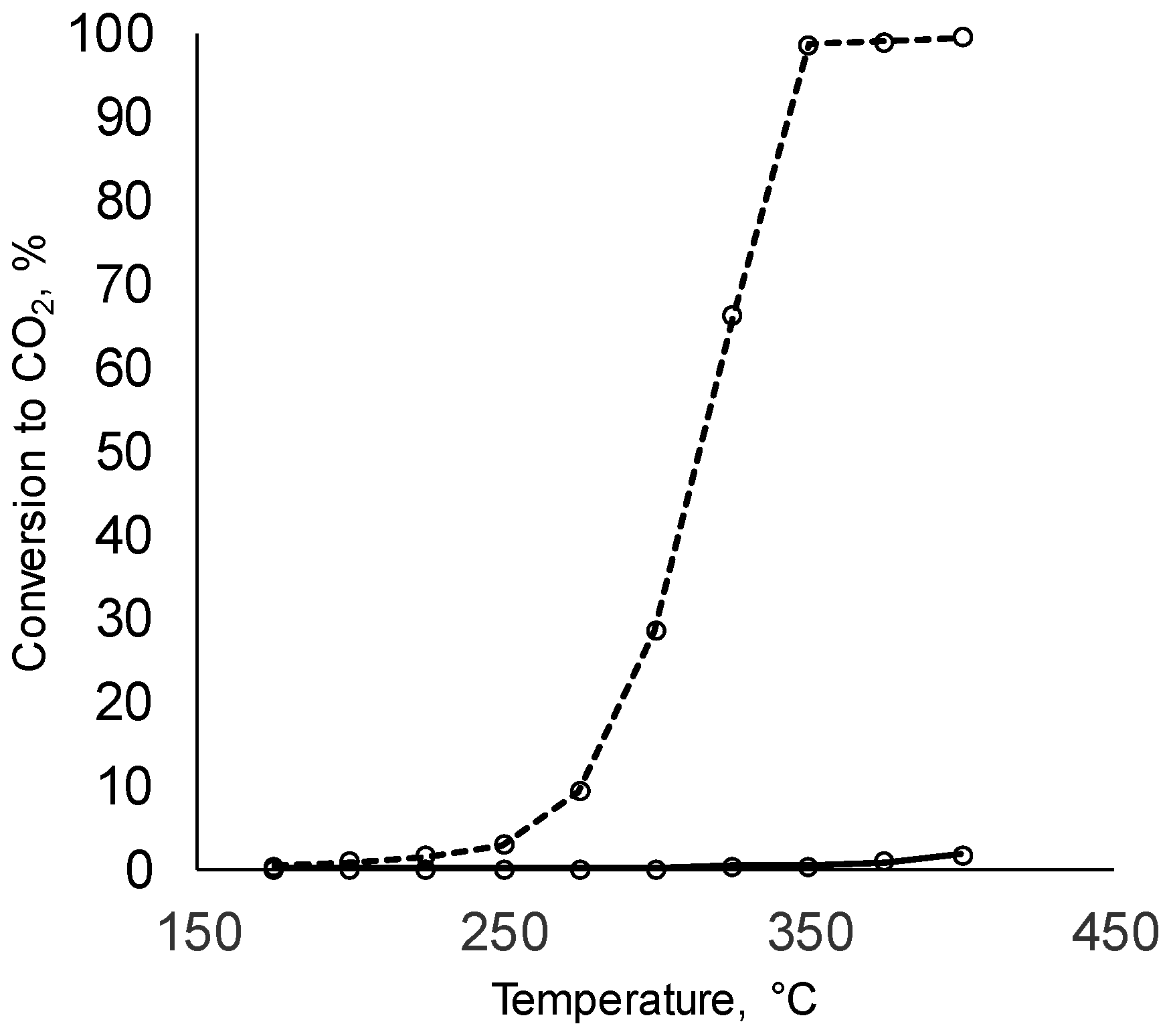
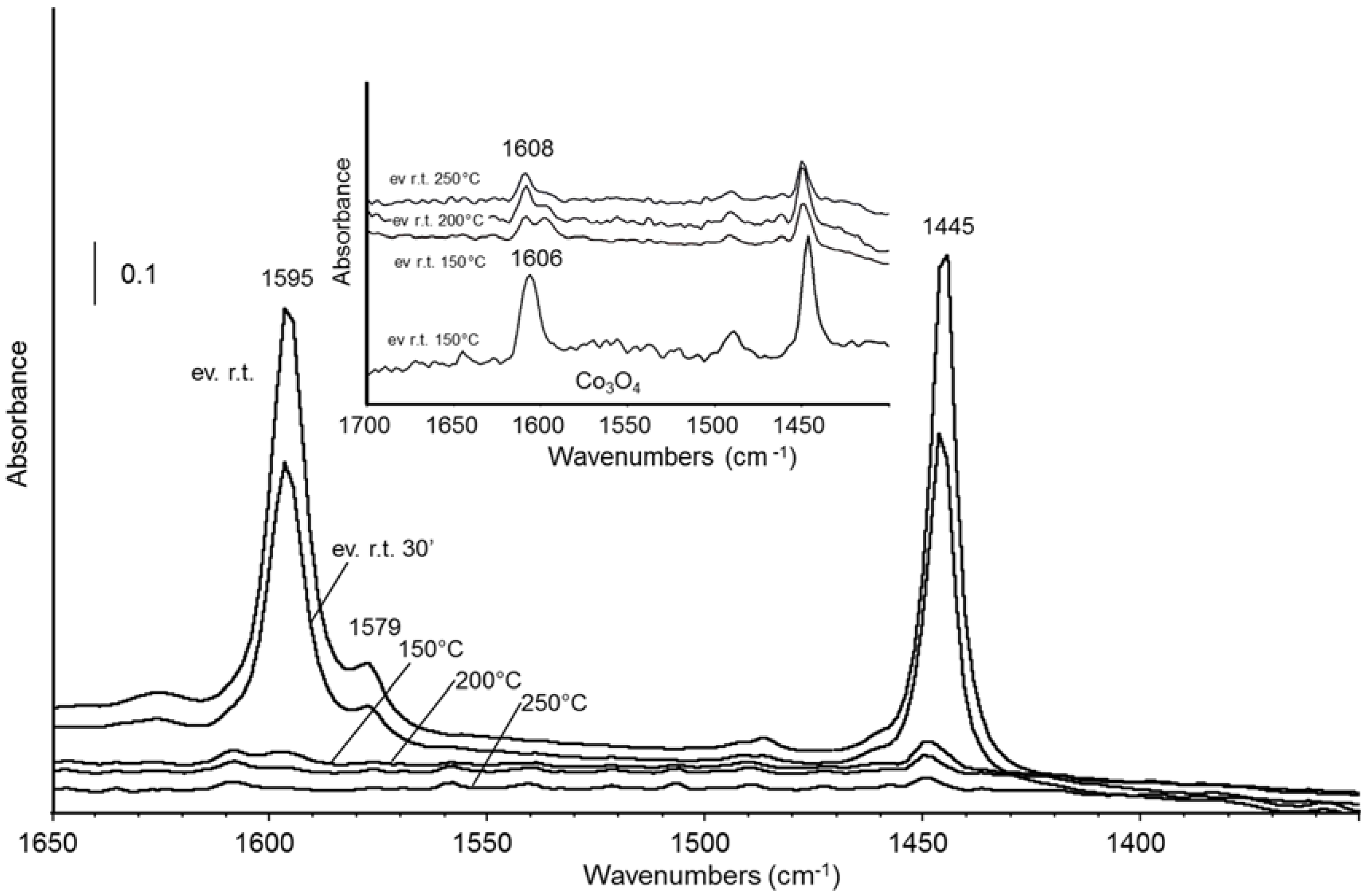
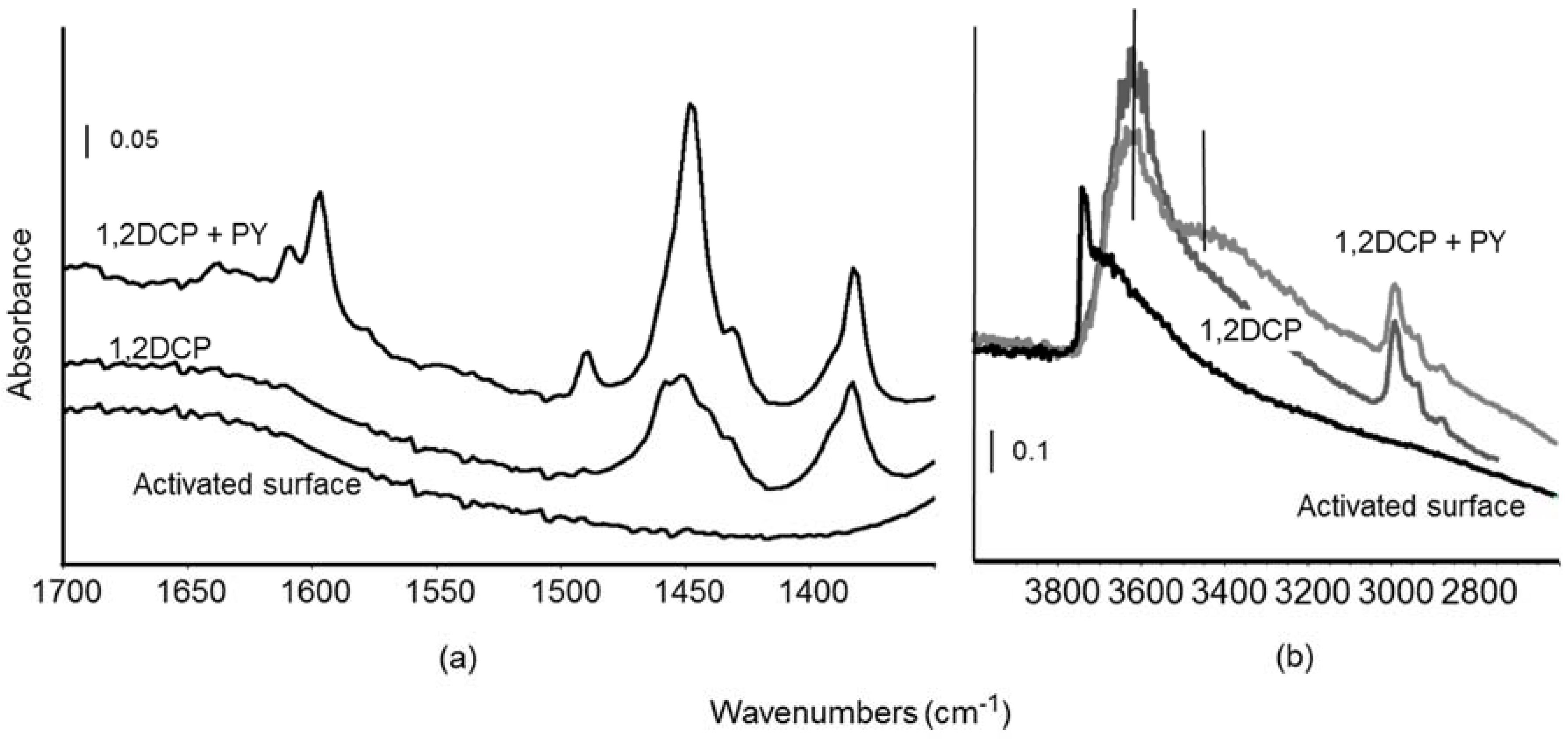
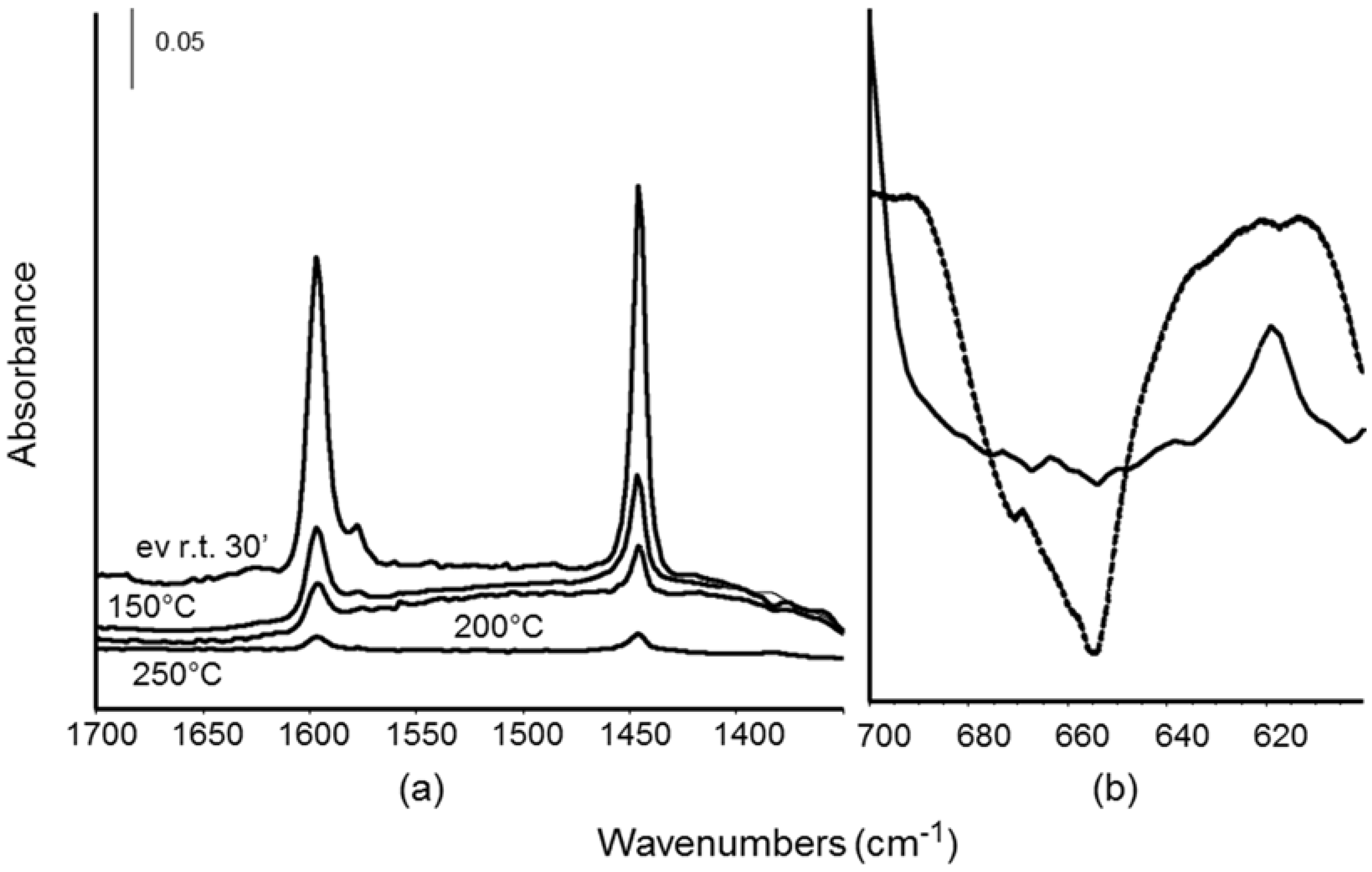
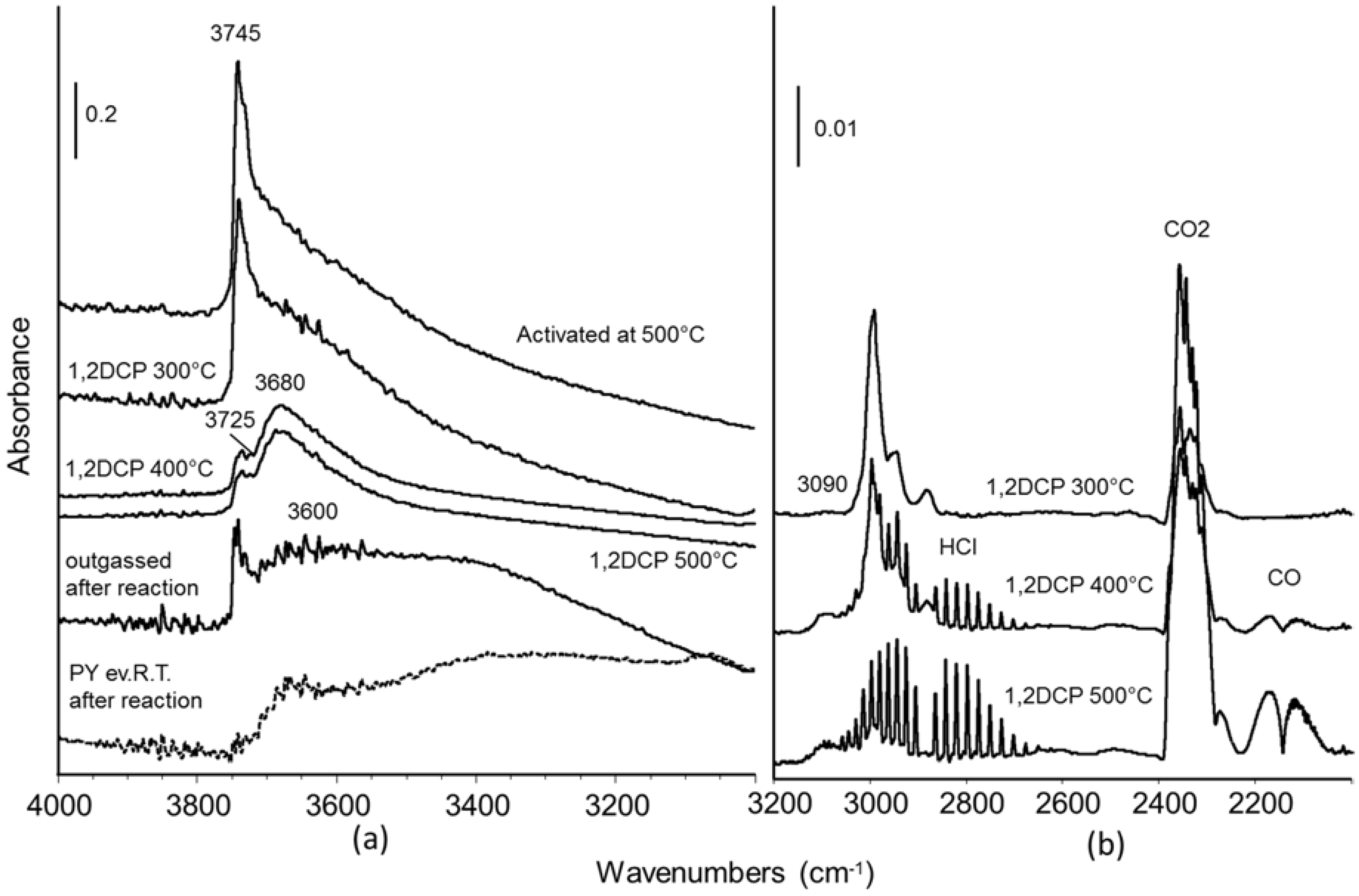
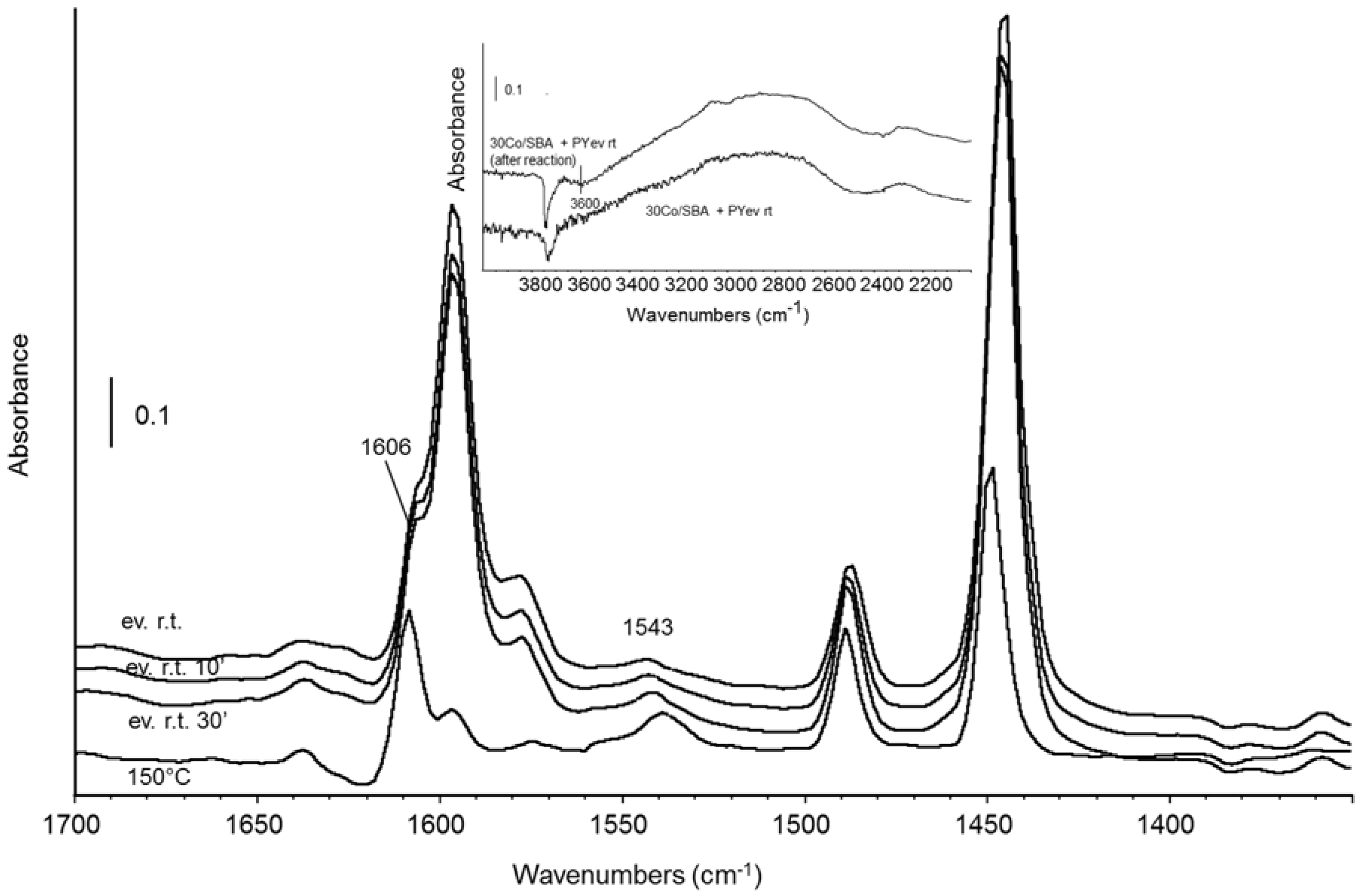
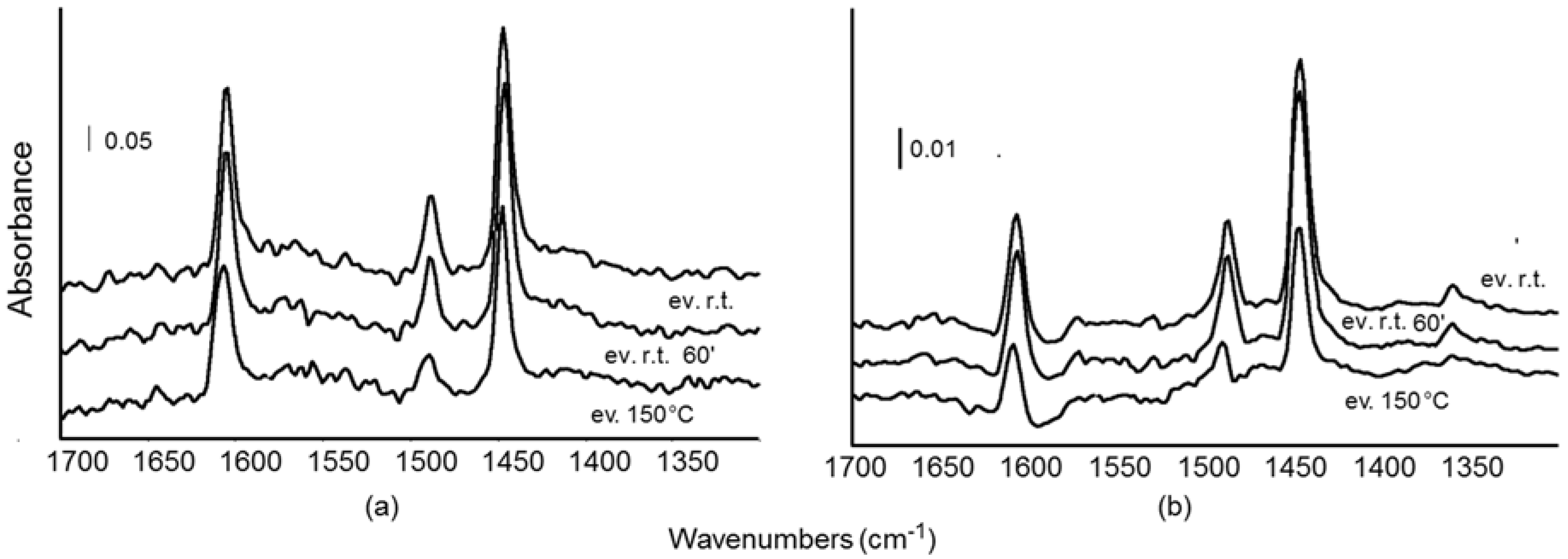
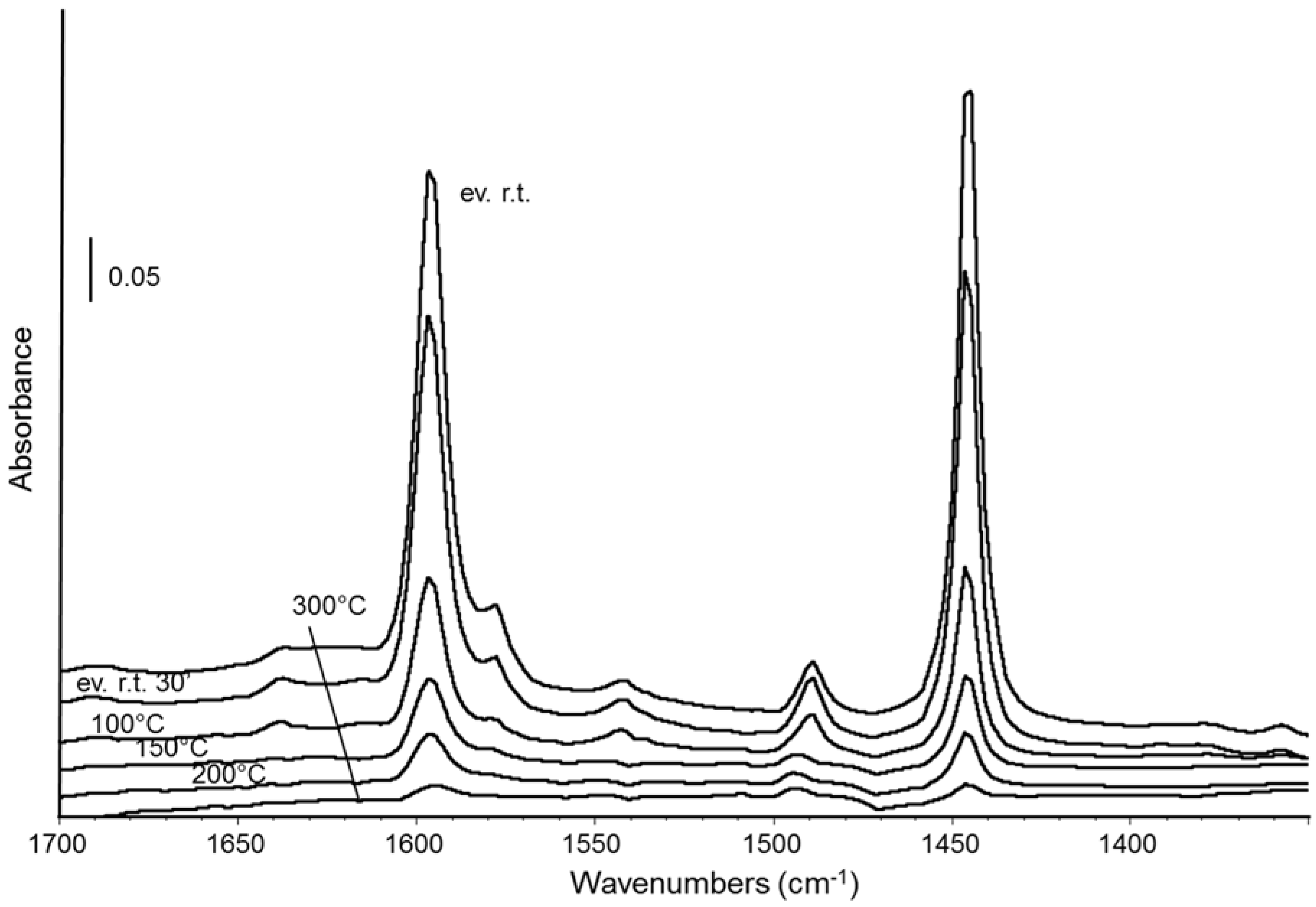
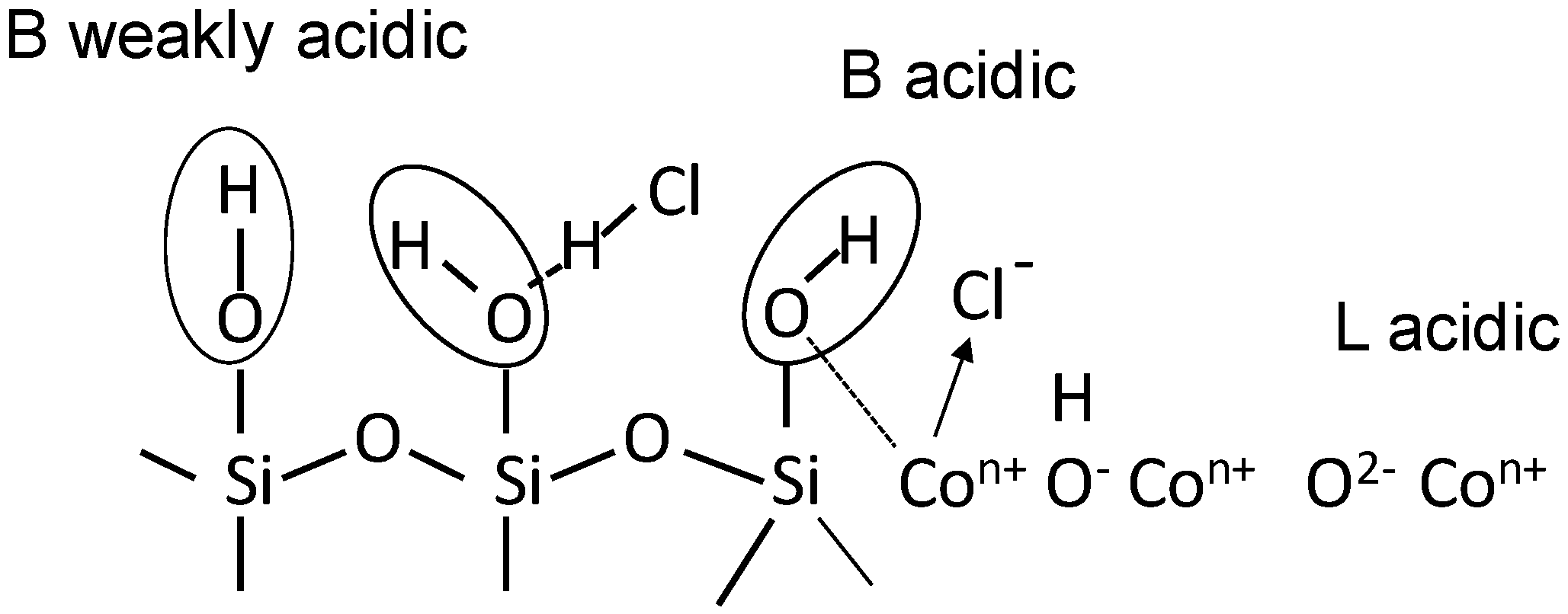
© 2018 by the authors. Licensee MDPI, Basel, Switzerland. This article is an open access article distributed under the terms and conditions of the Creative Commons Attribution (CC BY) license (http://creativecommons.org/licenses/by/4.0/).
Share and Cite
Finocchio, E.; Gonzalez-Prior, J.; Gutierrez-Ortiz, J.I.; Lopez-Fonseca, R.; Busca, G.; De Rivas, B. Surface Characterization of Mesoporous CoOx/SBA-15 Catalyst upon 1,2-Dichloropropane Oxidation. Materials 2018, 11, 912. https://doi.org/10.3390/ma11060912
Finocchio E, Gonzalez-Prior J, Gutierrez-Ortiz JI, Lopez-Fonseca R, Busca G, De Rivas B. Surface Characterization of Mesoporous CoOx/SBA-15 Catalyst upon 1,2-Dichloropropane Oxidation. Materials. 2018; 11(6):912. https://doi.org/10.3390/ma11060912
Chicago/Turabian StyleFinocchio, Elisabetta, Jonatan Gonzalez-Prior, Jose Ignacio Gutierrez-Ortiz, Ruben Lopez-Fonseca, Guido Busca, and Beatriz De Rivas. 2018. "Surface Characterization of Mesoporous CoOx/SBA-15 Catalyst upon 1,2-Dichloropropane Oxidation" Materials 11, no. 6: 912. https://doi.org/10.3390/ma11060912
APA StyleFinocchio, E., Gonzalez-Prior, J., Gutierrez-Ortiz, J. I., Lopez-Fonseca, R., Busca, G., & De Rivas, B. (2018). Surface Characterization of Mesoporous CoOx/SBA-15 Catalyst upon 1,2-Dichloropropane Oxidation. Materials, 11(6), 912. https://doi.org/10.3390/ma11060912






